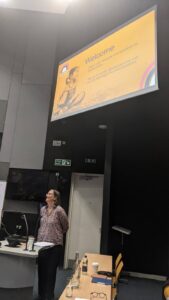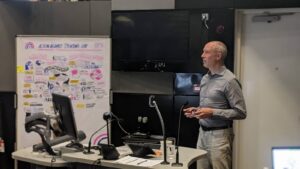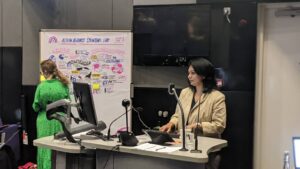Latest news
Global experts discuss action to tackle stunting and reach Zero Hunger
September 21, 2022
Text: João Pedro Costa
Photo: João Pedro Costa. Graphic Facilitator Eleanor Beer live drew the second Action Against Stunting Hub.
 The second Action Against Stunting Day on 8 September 2022 attracted leading experts and policy-makers within stunting and nutrition. After defining the key priorities in 2021, the second Action Against Stunting Day explored how to advance a just transition to sustainable food systems and food security through appropriate policies, investments and support. Professor Liam Smeeth, Director of LSHTM, and Professor Claire Heffernan, Director of LIDC and Principal Investigator of The Action Against Stunting Hub, opened the day with an overview of the scale of the challenges faced globally. Worldwide, 149 million children suffer from stunting. That is 149 million children who may never reach their full potential.
The second Action Against Stunting Day on 8 September 2022 attracted leading experts and policy-makers within stunting and nutrition. After defining the key priorities in 2021, the second Action Against Stunting Day explored how to advance a just transition to sustainable food systems and food security through appropriate policies, investments and support. Professor Liam Smeeth, Director of LSHTM, and Professor Claire Heffernan, Director of LIDC and Principal Investigator of The Action Against Stunting Hub, opened the day with an overview of the scale of the challenges faced globally. Worldwide, 149 million children suffer from stunting. That is 149 million children who may never reach their full potential.
Dr Luz María De-Regil (WHO) explored the impact of coexisting forms of malnutrition, and the importance of moving multilaterally when implementing a nutritional transition. Today, 124 countries experience a high level of at least two types of malnutrition, and as many as 41 countries experience a high level of at least three types. Different types of malnutrition can share common pathways, meaning that conditions can be addressed simultaneously to help prevent e.g. both stunting and the onset of obesity. Dr De-Regil proposed joint implementation of interventions in areas as diverse as taxation, product marketing and labelling, and school food procurement policy.
Dr Patrizia Fracassi (FAO) warned that “humankind faces a perfect storm of climate change, biodiversity loss and multiple forms of malnutrition”, pointing out that food is at the centre of all three issues. Biodiversity and healthy diets are two key elements for climate change adaptation and mitigation. Dr Fracassi proposed solutions such as preserving the nutrients of crops, enriching the nutrient content of staple food and selecting local varieties of foods resistant to climate change.
 Dr Saul Morris (GAIN) looked at a range of animal breeds for human consumption, and the differences between home-produced and marketed foods. Perhaps his most striking example was how picking the ‘right’ breed of chicken can increase the number of eggs a family gets from each chicken from 80 to 230 per year.
Dr Saul Morris (GAIN) looked at a range of animal breeds for human consumption, and the differences between home-produced and marketed foods. Perhaps his most striking example was how picking the ‘right’ breed of chicken can increase the number of eggs a family gets from each chicken from 80 to 230 per year.
Global challenges require global cooperation, and the second Action Against Stunting Day benefited from experts who offered their perspectives from across the globe. Professor Babacar Faye (UKRI-GCRF Action Against Stunting Hub Senegal) reminded us about the important role of Low- and Middle-Income Countries’ scientists in nutrition security in a disrupted global context. Countries have their own ministers of health who should be consulted and involved in designing and implementing solutions.
 The Action Against Stunting Day coincided with India’s annual National Nutrition Week, where there is a nutrition disconnect caused by a gap in the availability, production and consumption of foods. Indian representation at the event was strong, with Dr Bharati Kulkarni (UKRI-GCRF Action Against Stunting Hub India), Professor Anish Sinha (IIPH Gandhinagar) and Professor Komal Shah (IIPH Gandhinagar) all providing updates on the situation in the country. This included the impact of COVID-19 and lockdowns, as well as the importance of considering developmental origins of health and disease alongside genetically inherited BMI and body fat relationship when tackling early childhood nutrition programmes.
The Action Against Stunting Day coincided with India’s annual National Nutrition Week, where there is a nutrition disconnect caused by a gap in the availability, production and consumption of foods. Indian representation at the event was strong, with Dr Bharati Kulkarni (UKRI-GCRF Action Against Stunting Hub India), Professor Anish Sinha (IIPH Gandhinagar) and Professor Komal Shah (IIPH Gandhinagar) all providing updates on the situation in the country. This included the impact of COVID-19 and lockdowns, as well as the importance of considering developmental origins of health and disease alongside genetically inherited BMI and body fat relationship when tackling early childhood nutrition programmes.
One of the most challenging policy changes needed, revolve around interventions that tackle undernutrition and overnutrition simultaneously. Research on the long-term impact of COVID infection on stunted children and pregnant women is ongoing, as are the health outcomes and risk factors with COVID and vaccination status during the antenatal period where stunting is a factor.
Dr Umi Fahmida (UKRI GCRF – Indonesia) presented some of the findings from the observation of a cohort of pregnant women, recruited during the COVID-19 pandemic in Lombok, Indonesia. Problematic nutrients identified included deficiencies in iron, zinc and calcium. In addition, there is an opportunity to redefine stunting from a functional perspective that includes the education environment, home environment, food environment and shared values, which are particularly important in the nutrition of children.
Grainne Moloney (UNICEF) presented UNICEF’s Nutrition Strategy 2020-2030, highlighting forces driving child malnutrition: globalisation, urbanisation, climate change and inequality. UNICEF is working on the premise that prevention of all forms of malnutrition comes first in all contexts, but if prevention fails, treatment is a must.
The cost of global malnutrition is astronomical. Far too many children suffer from malnutrition in all its forms. Radical transformation and significant investment are needed now more than ever. But there is hope. Globally, the level of child stunting has fallen over the past decades. It is by coming together that solutions can be found and action can be taken. In Prof. Smeeth’s words, “the world needs you”. We look forward to next year’s Action Against Stunting Day.

